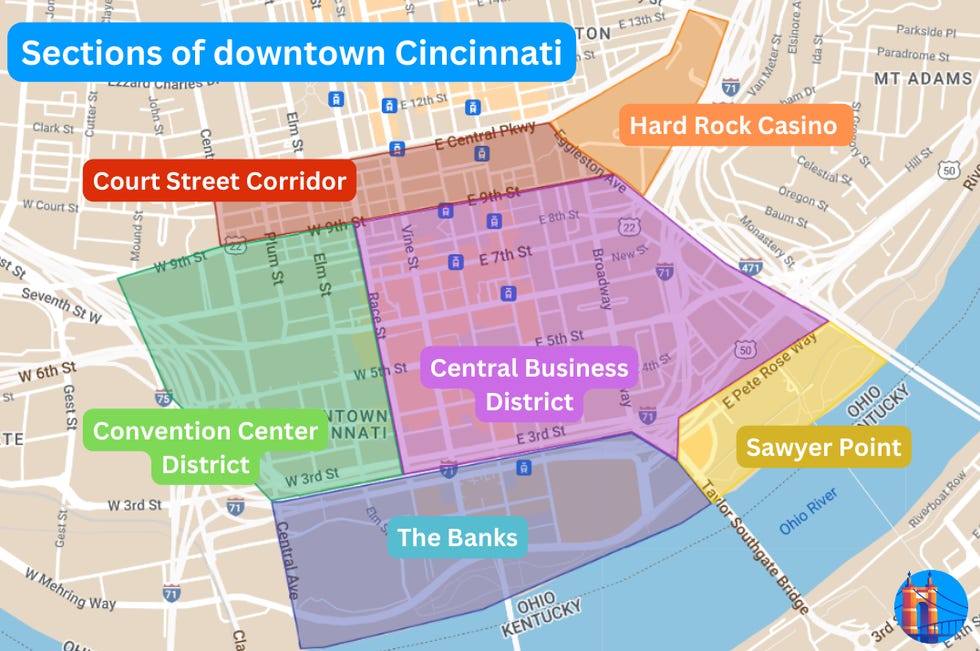

Isaac Wright was driving through the Arizona desert with a friend when traffic stopped. A helicopter buzzed overhead. Wright thought it was a crash.
It was December 2020. He had just finished six years of Army service and was headed to Las Vegas. It was his first major commercial photography shoot, the start of a new chapter in his life.
Then his car was surrounded by officers, guns out. He was pulled out and handcuffed there on the highway, and taken to jail on a warrant out of Cincinnati.
Months before he had climbed to the top of Queen City Tower to take photos. According to police, a security guard saw him on camera and raised the alarm prompting a SWAT team to respond.
Wright knew he had an open warrant, but said he did not know it was for multiple felonies, didn't know Cincinnati police were tracking his location and didn't know a nationwide manhunt had been launched to bring him in.
He learned in Arizona that the officers there were told he was a potentially armed military veteran with special operations training and a PTSD diagnosis. They seemed unaware that he was wanted in connection to a clandestine photo shoot.
Thus began Wright's stint in jail.
As well as his education in how the judicial process really works, especially if you have no money.
Arrested
Wright was 25 when he was arrested. He had gone straight into the Army after he graduated from Colerain High School, a sprawling suburban district just outside Cincinnati.
He had skipped his graduation ceremony to instead attend a military ceremony at Great American Ball Park, a location he would later photograph with his feet dangling off the top deck. Cincinnati police filed charges against him for that, too.
When he joined the Army, he didn't have dreams to be special ops. He wanted to be a chaplain.
By 2017, he was at Fort Polk, an isolated base in Louisiana. The claims police made about Isaac's background were true. He did have "special operations" training. He had trained to join the paratroopers and attended SERE (survival, evasion, resistance and escape) school.
But he had also worked, as he had hoped, as an ad hoc chaplain, filling in as needs dictated.
"When I joined 3rd Brigade Combat Team, 10th Mountain Division the unit was finishing a rotation fighting in Iraq," Wright explained. "It was April of 2018, part of my job was helping our soldiers reintegrate into life at home after deployment. Without a chaplain in the unit, many soldiers came to me for counseling and to talk about their struggles with suicide."
He said he was counseling and checking in on up to five to 10 soldiers at a time throughout the week. But he still lost soldiers, friends.
"I was connected to two soldiers we lost very personally. They were on my suicide watch list that I made efforts to meet and talk to every week," Wright said.
In 2018, 325 active-duty service members, 81 members of reserves, 135 members of the National Guard and 6,435 veterans died by suicide, according to the Department of Defense.
That counseling work was emotionally hard for Wright. The losses added up and he found himself with his own post-traumatic stress disorder.
It was photography, his art, that he says has helped him cope with this trauma.
"To watch a soldier walk into your office and struggle and not be able to save them is crushing (and) something you don't forget," Wright said.
But now it was Christmas 2020 and Wright was in a cell in the Coconino County jail.
Shooting
After his military service, he said he found solace in photography. Under the moniker Drifter Shoots, he took daring shots from the tops of skyscrapers and bridges all over the world.
At the time of his arrest, he had 13,000 followers on Instagram. Now, he has over 125,000 on Twitter, which is where he says he puts most of his social media efforts these days.

Police said that entering restricted areas of buildings, some of which could be targeted for acts of terrorism, was a serious matter. Cincinnati officials said Wright didn't just walk into places he wasn't supposed to be but instead broke in. This is something Wright denies.
"You can say that my work has blurred legal lines in regards to trespassing, but breaking and entering, burglary? No," he said while still in jail. "I did not break into the building."
Jailed
Isaac was in that Arizona jail on a "holder" waiting for officers in Cincinnati to come pick him up or arrange for other transport.
There's no set time limit for holders. They are set by judges, who may limit the time a person will sit in jail or may not.
In Wright's case, it took 45 days for the authorities to get him back to Cincinnati. He got back in town on a Thursday. His lawyer, Laurence Haas, expected that he could have him out of jail on bond the next day.
But that didn't happen.
Haas has been practicing law for a decade. He said he's never seen police and prosecutors work so hard to capture someone and then keep them in jail.
After Wright was in custody, police seized his camera. Cincinnati officers continued to alert law enforcement across the country to his activities. Police said they expected charges would be levied against him in seven different states.
A Cincinnati police detective told a judge Wright "terrorized" the city of Houston when he took photos there, broke into five buildings in Chicago and eluded 10 to 12 agencies during his trip to Las Vegas. The detective called it a "crime spree."
Neither Houston nor Chicago ever filed charges against him for anything.
Still, a new charge from Michigan and additional charges in Cincinnati meant Wright was kept in jail here while those matters were sorted out.
In late February, he was ready to post his $2,600 bond– 10% of $26,000 – and get an ankle monitor, but prosecutors asked for an emergency bond hearing.
"Stealth and deception are his trademarks," Assistant Prosecutor Anne Flanagan told the judge. "We don't know what other motive he may have ... but we do know what training he has."
His bond was raised to $400,000.
Accused
Wright and Haas went to court again to have his bond lowered. Wright also issued a public apology to the Reds.
There was no dispute that Wright had taken the photos from the different skyscrapers and stadiums, but he and Haas maintained that he did not commit the felony-level offenses of which he had been accused.
Haas said his client was overcharged. If convicted on all of the charges in Cincinnati alone, Wright could have been sentenced to 20 years in prison.
Hamilton County Common Pleas Judge Lisa Allen eventually lowered his bond to $10,000.
All told, Wright spent 114 days in police custody before his release on April 9, 2021.
But his case wasn't over yet.
Arrested, again
While Wright was fighting to get released on bond, new charges had been filed in Louisiana, and Wright traveled there to address them.
On his way back, he was arrested again on a misdemeanor warrant out of Kentucky tied to photographs he made from the top of the Roebling Suspension Bridge. His car was impounded, and he was stranded in western Kentucky, but still made his court date in Cincinnati that Monday.
Authorities in Kentucky said it was Cincinnati police they were communicating with to coordinate the arrest, Wright said.
When another set of charges came in from Philadelphia, Colerain Township and Cincinnati police came to Wright's father's house to arrest him again.

While Cincinnati police said they expected charges to come in from across the country, only four other jurisdictions have filed charges.
In Michigan and Philadelphia, the charges were dropped within days. In Kentucky, Wright was sentenced to complete a diversion program for the misdemeanor charge. The case in Louisiana is still pending.
No charges have been filed as a result of Wright's activities in Houston, Chicago or New York.
In November, Hamilton County Judge Lisa Allen accepted a plea agreement for Wright. Under the "treatment in lieu of conviction" arrangement, Wright would have to stay out of trouble and get counseling. If he did this, the charges against him would go away after a year or two. The judge will decide when he's met his obligation.
Through all of this, Wright's legal fees were mounting and he was determined to keep his dream alive of becoming an artist. And more and more people were noticing his work. His story even got national attention in the New York Times.
His popularity was growing alongside the fledgling NFT market. Non-fungible tokens use the same technology as cryptocurrency to allow digital assets to be sold and their ownership verified.
This meant that a relatively poor guy was getting richer by the minute. It meant he was not indigent now but a rather privileged defendant.
Paying twice
During Wright's time in jail, he said he got a close look at the world of cash bond. Who is targeted and how. Who can pay and who can't. And what that all means.
There were people, he saw, who were stuck in jail for minor offenses. There were others who had to choose between paying a bond or hiring a lawyer.
It was here that Wright decided he wanted to do something to give back, specifically to Hamilton County. Then, he came across the Bail Project.
Robin Steinberg is the founder of the California-based nonprofit Bail Project, which pays cash bonds for people who can't afford them. The nonprofit also fights against cash bonds at the government level and offers other services to help individuals caught up in the legal system.
She said 60% of the people in Ohio jails are there because they can't pay a cash bond. She said judges are also more likely to set cash bonds for Black people and that bonds are higher for Black people as well.
"Cash bail is creating a two-tiered system of justice, both on an economic level, but also on a racial justice level," Steinberg said.
The Bail Project launched in Cincinnati in 2020. Since then the project has paid $1.5 million in bail in Hamilton County on behalf of 303 people, Steinberg said. That's an average of $5,000 per person.
In most cases, the money can be reused. That's because if a person pays a bond, the money is returned when the case is over as long as they show up for court and do what the judge orders them to do.
The point of a cash bond is to ensure a person will return to court. The Bail Project reports that, nationally, 94% of those who pay bonds return to court.
Steinberg said bonds are often used as leverage to get people to plead guilty to charges. She said for many people the choice between pleading guilty then serving a short jail sentence or probation and sitting in jail for months while their case progresses is an easy one, but it can harm a person for years to come.
She said the power of cash bond as a prosecutorial tool is obvious when you look at what happens when the Bail Project steps in.
"Of the 303 people we bailed out, 50% of people's cases have been dismissed in their entirety, which tells you a lot about the overreach of the criminal justice system, about ensnaring people that shouldn't be in it to begin with," she said.
Hamilton County Prosecutor Joe Deters did not respond to requests for comment on this story. He has, in the past, been a strong opponent of bail reform efforts at the state level. He has repeatedly said that there is no one being held at the Hamilton County Justice Center that doesn't need to be held there.
Bonanza
Release is what Wright was trying to figure out. The photographer said even though he had built up a fan base before his arrest through social media, there wasn't an art gallery in the world that would have considered carrying his work.
The NFT market changed that, he said, and the art market no longer had to play by the rules set by traditional markets.
"I saw it and immediately knew that that's how I was going to pay for my cases," Wright said. "It was a do-or-die situation for me."

It did pay for his cases and then some. His NFTs quickly gained traction as the market exploded. His work– like photographs taken from the dizzying heights of skyscrapers – was selling for tens of thousands of dollars. In less than a year, Wright went from having about $9,000 in his bank account, money he had saved from his time in the Army, to being a millionaire.
The traditional art market even began to recognize him. He sold a collection called "Where My Vans Go," referring to his shoes that feature in many of his photos, at a Sotheby’s auction house for nearly a quarter of a million dollars.
Wright said the plan for an "open edition" to raise money for bail relief and reform started to take shape early. While many NFTs are traded as individual units or limited sets, an open edition is usually sold for a limited time period with no limits set on the number.
"First Day Out" was released in April on the anniversary of Wright posting bond. The price was set at $700 in order to make it more affordable.
Though he sold most of his NFTs through established online marketplaces, Wright said that involves those marketplaces taking a cut of the sales. For the open edition, he had his own specially designed contract that cut out the middleman.
He sold 10,400 NFTs, 15% of which would go toward the Bail Project. With fluctuations in the cryptocurrency market that meant Wright was able to donate $500,000 to the project.
While the Bail Project operates all over the country, Wright's donation is earmarked for use only in Hamilton County.
The photo for the open edition shows Wright on a suspension wire of the Manhattan Bridge looking toward the Brooklyn Bridge and the New York City skyline. He said the image says so much about him.
"I never stopped being an artist. That picture, it looks like I'm dreaming," he said. "You're looking at the skyline. It's foggy and it's beautiful and the city lights are flashing. I'm looking towards bigger and better things and better days."
Wright said he wanted to make sure the image carried a message of freedom.
"When you're sitting inside four walls, a lot of time for 23 hours a day like that, all you have is your imagination," he said. "And if imagination dies, then your hope dies with it. Once your hope dies, you're gone, too."
"For me, it was keeping that imagination alive. That picture I felt like embodied it more than any other photo that I have. I'm in that picture and I'm free in every single way."
Source link








